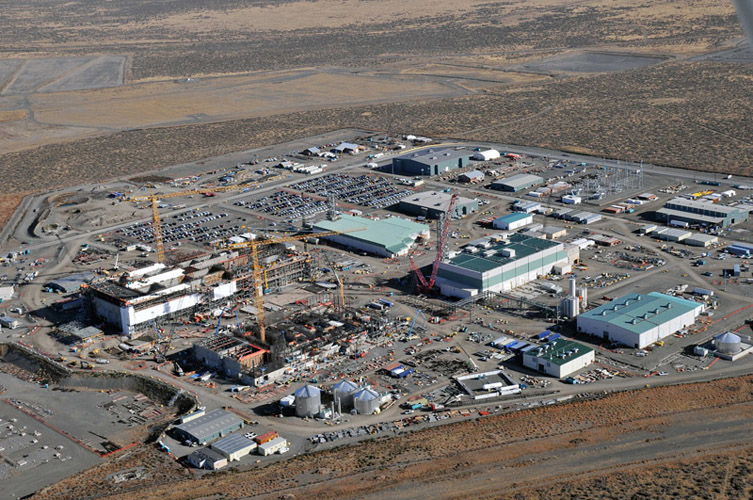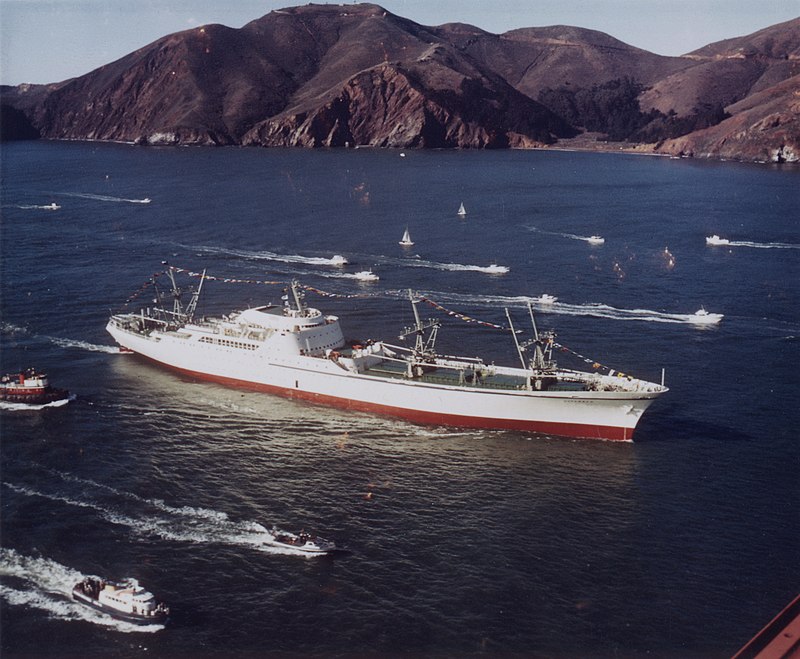The ICP buried waste retrieval team successfully completed targeted TRU waste retrieval at the INL Site. The effort spanned 17 years and resulted in the exhumation of more than 10,000 cubic meters of buried TRU waste from 5.69 acres of the site’s Subsurface Disposal Area. (Photo: DOE)
The Department of Energy recently honored eight teams from its Office of Environmental Management (EM) with Secretary of Energy 2022 Achievement Awards. The awards recognized projects at the DOE’s Idaho, Savannah River, and Hanford sites, as well as a group of employees that revamped and expanded DOE-EM’s Minority Serving Institutions Partnership Program (MSIPP-EM). In addition, DOE-EM employees on crosscutting departmental teams received awards.
The awards were part of the DOE’s annual Honor Awards, the agency’s highest form of employee recognition for excellence and achievement.
Hanford’s Waste Treatment and Immobilization Plant. (Photo: DOE)
The Department of Energy is asking for feedback on a new report analyzing potential options for preparing high-level radioactive waste for vitrification at the department’s Hanford Site near Richland, Wash. Vitrification is the process of treating radioactive waste by immobilizing it in glass.
The report, Waste Treatment and Immobilization Plant High-Level Waste Treatment: Analysis of Alternatives, was commissioned in response to a 2018 determination by the U.S. Army Corps of Engineers that it was unlikely the DOE would meet its mandated deadlines for treating Hanford’s tank waste.
The first shipment of downblended surplus plutonium from SRS’s K Area leaves SRS. (Photo: DOE)
The Department of Energy’s National Nuclear Security Administration and Office of Environmental Management have completed the first shipment of downblended surplus plutonium transuranic (TRU) material from the K Area at the Savannah River Site in South Carolina to the Waste Isolation Pilot Plant in New Mexico.
The NS Savannah, the world’s first nuclear-powered merchant ship. (Photo: NARA)
The U.S. Department of Transportation has drafted a programmatic agreement (PA) on the decommissioning the NS Savannah, the world’s first nuclear-powered merchant ship. Christened in 1959 under President Dwight Eisenhower’s Atoms for Peace initiative, which challenged world leaders to develop peaceful uses of nuclear power, the ship served as a demonstration project for the potential maritime use of nuclear energy.
Construction is underway on the Paducah Site's new Emergency Operations Center. (Photo: DOE)
Construction crews at the Department of Energy's Paducah Site in Kentucky have broken ground on a new Emergency Operations Center (EOC) to improve coordination and response to emergencies across the site.
The 3,500-square-foot facility will replace the existing EOC, which was established in the site’s C-300 Control Building around 1990. The C-300 Control Building was built during the 1950s. The new modern facility will be used to monitor environmental conditions and house emergency management personnel.
The new EOC is scheduled for completion in this year.
A video is available on the construction of the new EOC.
A screen capture from the DOE's West Valley video. (Image: DOE)
A new animated video from the Department of Energy's Office of Environmental Management (EM) shows how cleanup contractor CH2M HILL BWXT West Valley (CHBWV) will take down the main plant process building at the West Valley Demonstration Project (WVDP).
The EM team at West Valley wanted to convey the project to the public, and they believe the animation accomplishes that goal, according to Stephen Bousquet, EM WVDP federal project director for the Main Plant Deconstruction Project.
Click here to watch the video.
The Ignalina nuclear power plant. (Photo: INPP)
A consortium comprising Westinghouse Electric Spain, Jacobs, and the Lithuanian Energy Institute has been selected to plan dismantling and waste management at the long closed two-unit Ignalina nuclear power plant in Lithuania.
The Integrated Waste Treatment Unit at the Idaho National Laboratory Site. (Photo: DOE)
The Department of Energy’s Office of Environmental Management (EM) said that the Integrated Waste Treatment Unit (IWTU), the radioactive liquid waste treatment facility at the Idaho National Laboratory Site, began its final heat-up in December prior to initiating radiological operations, planned for early this year.
IWTU crews were to follow a prescribed incremental process as the facility transitions from simulant to sodium-bearing waste (SBW), according to EM.
An aerial view of Hanford’s Plutonium Uranium Extraction plant, showing the main facility (at center), the 211-A chemical storage area, and (in foreground) the 203-A acid storage area. (Photo: DOE)
Work crews at the Department of Energy’s Hanford Site in Washington state are performing risk-reduction activities at the Plutonium Uranium Extraction (PUREX) plant to prepare it for eventual disposition.
“It will be a yearslong effort to get this large facility ready for disposition, and I’m encouraged by the progress to safely and efficiently advance this work,” said Andy Wiborg, the DOE’s Projects and Facilities Division team lead for Hanford’s Central Plateau cleanup project.
A radiological control technician checks radiation readings on waste containers at WIPP. (Photo: WIPP)
The New Mexico Environment Department (NMED) is adding several conditions to the operating permit for the Department of Energy’s Waste Isolation Pilot Plant (WIPP) near Carlsbad, N.M. The permit changes, which would prioritize the disposal of transuranic (TRU) waste generated in the state and limit the repository’s capacity, are contained in a fact sheet the NMED.
A tanker holding 6200 gallons of leachate unloads at a backup load-in station at the Hanford Site’s ETF. (Photo: DOE)
Construction of a backup load-in station has been completed at the Hanford Site’s Effluent Treatment Facility (ETF) in Washington state.
“We broke ground on the backup facility about a year ago,” said Rob Wood, project manager for Washington River Protection Solutions, the Department of Energy’s tank operations contractor at the site. “I am proud of the team for completing this portion of the load-in expansion project and doing it safely. In phase two, expansion of the main load-in station will prepare us for 24/7 operations on the Hanford Site.”
Watch a time-lapse video of the backup load-in station construction here.
Workers walk down a passageway in Panel 8 at the Waste Isolation Pilot Plant in November. (Photo: DOE)
Employees have begun emplacing defense-related transuranic (TRU) waste in Panel 8 of the Waste Isolation Pilot Plant (WIPP) in New Mexico, the Department of Energy’s Office of Environmental Management (EM) announced in November. TRU waste is permanently disposed of at WIPP in rooms mined in a Permian salt bed 2,150 feet below the surface.
Crews completed the teardown of Oak Ridge’s Bulk Shielding Reactor (Building 3010), once used for research as part of the federal Aircraft Nuclear Propulsion Program. (Photos: DOE)
The Department of Energy’s Office of Environmental Management (EM) said its cleanup contractor UCOR recently completed the first-ever demolition of a reactor in the central campus area at the Oak Ridge National Laboratory in Tennessee.
Demolition and disposal shifted into high gear this spring at the DOE’s former uranium enrichment plant in Ohio.
In the 1950s, the U.S. Department of Energy constructed the Portsmouth Gaseous Diffusion Plant in rural southern Ohio to enrich uranium, alongside two other federally owned and managed facilities in Oak Ridge, Tenn., and Paducah, Ky. The Cold War-era plant was built as a self-sufficient industrial city with more than 400 buildings and facilities centered around three massive gaseous diffusion process buildings that could enrich the level of the uranium-235 isotope for nuclear fuel in the defense and energy sectors.
A screenshot from the Local 12 report. (Image: WKRC/Sinclair)
In May 2019, Zahn’s Corner Middle School in Pike County, Ohio, located within four miles of the former Portsmouth Gaseous Diffusion Plant (PORTS), was closed after local officials reported enriched uranium and transuranic radionuclides were detected inside the school and at outside air monitors.
Now, Cincinnati’s WKRC Local 12, a news affiliate of Sinclair Broadcast Group, is reporting that a private house in Lucasville, Ohio, 10 miles from the PORTS site, has been contaminated with enriched uranium.
















